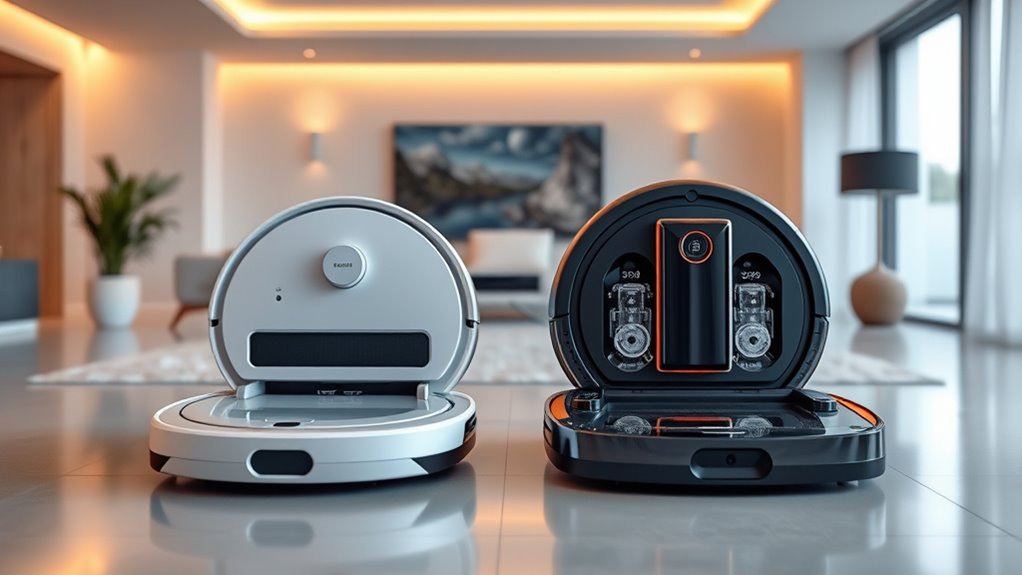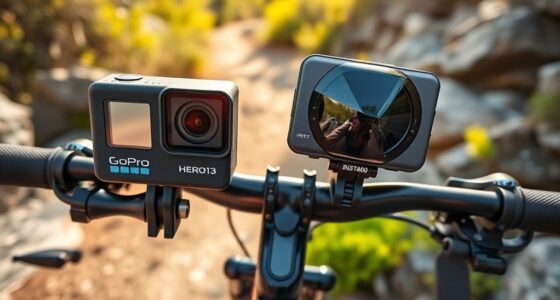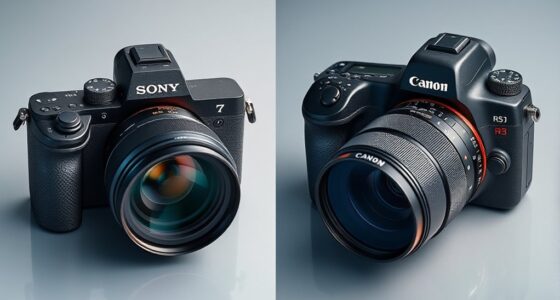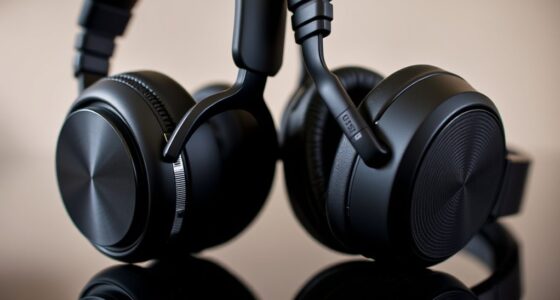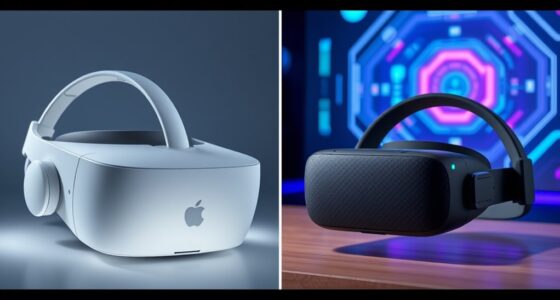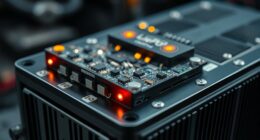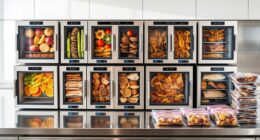If you’re choosing between the Roomba J9 and Roborock S8, consider their strengths: the Roomba J9 offers quieter operation, a sleek design, and excellent obstacle avoidance, while the Roborock S8 boasts stronger suction, better pet hair pickup, and more versatile cleaning features, especially for larger areas. Both support self-emptying, but each has unique base station benefits. Continue exploring to see which robot best fits your home’s needs and cleaning preferences.
Key Takeaways
- Roborock S8 offers higher suction power (6000 Pa) and advanced navigation features, making it more effective for heavy debris and pet hair.
- Roomba J9 has a quieter operation (55 dB) and a more discreet design, ideal for quiet environments and tight spaces.
- Both models feature self-emptying stations; Roborock’s includes automated mop cleaning and drying, while Roomba’s station empties into an internal bag.
- Roborock S8 provides longer runtime and more customizable cleaning zones, suitable for larger homes and complex layouts.
- Price-wise, Roomba J9+ is more expensive but offers premium obstacle avoidance, while Roborock S8 balances cost with advanced automation features.
Design and Build Quality Comparison
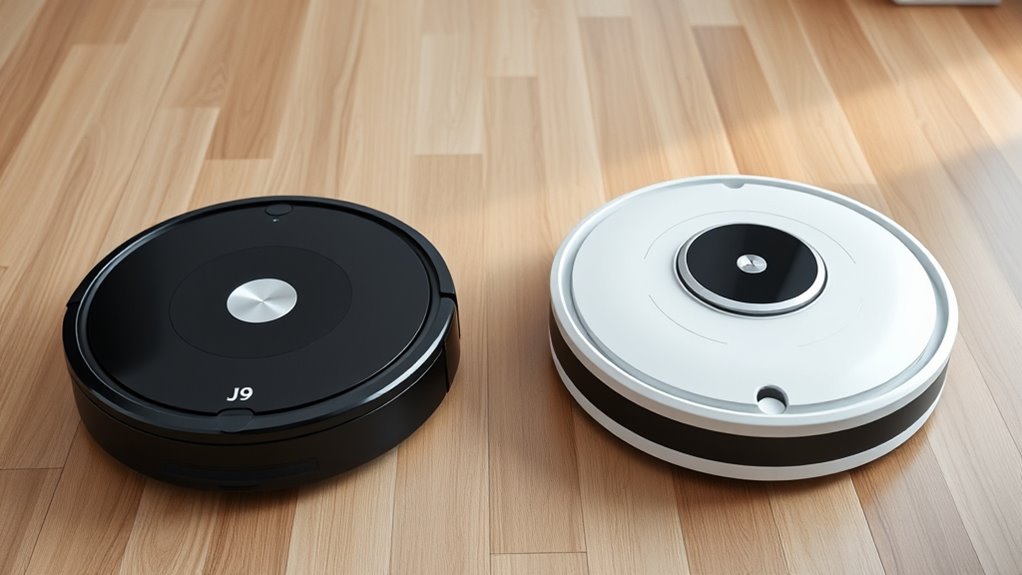
When comparing the design and build quality of the Roomba J9 and Roborock S8, you’ll notice distinct aesthetic choices that reflect their respective brands. The Roomba J9 features a stylish woodgrain finish on top, giving it a furniture-like appearance, and emphasizes a user-friendly design with visible dustbin and solution compartments. In contrast, the Roborock S8 has a sleek, high-tech look crafted from durable, water-resistant plastics, highlighting its functional features like water tanks and mop sections. Both robots have a low-profile design to navigate under furniture effectively. Their base stations are sturdy but differ in complexity: Roomba’s focuses on dust disposal and solution refill, while Roborock’s incorporates advanced mop cleaning and drying systems. Material quality and size balance performance with ease of use. Additionally, the choice of material quality significantly influences the overall durability and longevity of these devices. Moreover, the use of robust materials enhances resistance to daily wear and tear, ensuring a longer lifespan.
Cleaning and Vacuuming Performance Analysis
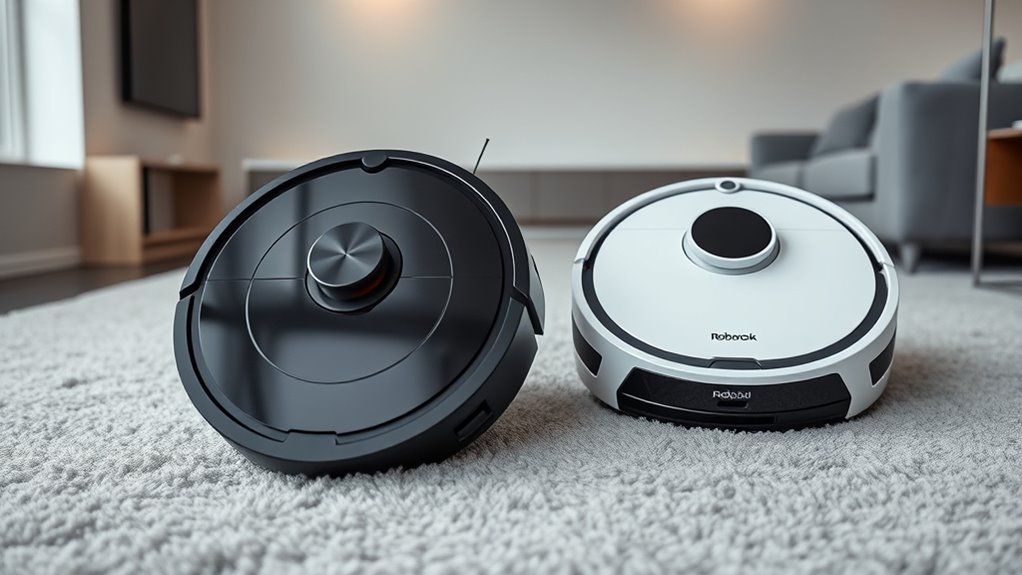
When it comes to cleaning and vacuuming, tangle-free rubber rollers keep pet hair and debris from clogging the brushes, ensuring smoother operation. You’ll also want to evaluate how well each robot shifts between different floor types and navigates around obstacles. Additionally, their path optimization technologies determine how efficiently they cover every inch of your space without missing spots. Maximizing space and organization features can also influence the robot’s ability to clean thoroughly by reducing clutter and creating clear pathways. Incorporating specialized brushes can further enhance cleaning performance on various surfaces. Moreover, integrating goal setting strategies can help users establish and maintain consistent cleaning routines for optimal results.
Tangle-Free Rubber Rollers
Both the Roomba J9+ and Roborock S8 utilize dual rubber rollers designed to minimize hair tangling, which considerably enhances their cleaning and vacuuming performance. These rollers feature soft rubber fins that flex to trap debris and hair without wrapping around the shaft, ensuring continuous contact with floors. The Roomba emphasizes easy removal and cleaning, reducing maintenance time, while the Roborock’s design effectively handles pet hair without frequent tangling. Their rubber construction works well on various surfaces, preventing damage to delicate floors. Thanks to this design, both devices maintain strong suction and debris pickup, even with hair buildup. Additionally, the use of HEPA filtration in some models helps capture allergens and airborne particles, boosting overall cleaning effectiveness. To further improve maintenance efficiency, manufacturers have integrated user-friendly features for quick roller removal and cleaning. Incorporating durable materials can enhance the longevity of these rollers, ensuring consistent performance over time. Overall, the tangle-free rollers improve efficiency, reduce maintenance, and ensure consistent cleaning performance across different floor types.
Carpet Transition Capability
Have you ever wondered how seamlessly a robot vacuum shifts from hard floors to carpets? Both the Roomba J9+ and Roborock S8 Pro Ultra do this automatically, with minimal user input. The Roomba J9+ lifts its mop completely off the floor when it detects carpet, preventing wet fibers and ensuring a smooth changeover. In contrast, the Roborock S8 Pro Ultra’s mop only raises about 5 mm, which can cause slight dragging on carpet edges. The S8 Pro Ultra boasts 20% more suction power, improving deep cleaning, while the Roomba excels with its superior mop lift and consistent suction optimization. Both models handle obstacles and edges well, but the Roomba’s mop retraction offers better carpet safety in mixed-floor homes. Additionally, carpet transition capability involves precise sensor technology that enables automatic detection and adjustment, enhancing overall cleaning efficiency.
Path Optimization Technology
Ever wondered how robot vacuums determine the most efficient cleaning routes? Both Roomba J9+ and Roborock S8 Pro Ultra use advanced mapping technologies to create detailed home maps, optimizing their paths. Roomba employs smart obstacle avoidance, detecting objects and steering around them effectively. Roborock’s 360-degree scanning allows for faster, more detailed map creation, especially in larger spaces. Its efficient algorithm and larger battery enable longer runtimes, finishing cleaning tasks quickly. Meanwhile, Roomba’s lower profile helps it access tight spots under furniture. Both models combine vacuuming and mopping, but Roborock’s superior routing reduces cleaning time in big areas. Customizable zones and virtual walls give you control, ensuring tailored, efficient cleaning sessions. Additionally, path optimization technology helps these devices plan the most effective routes, minimizing cleaning time and energy consumption. Incorporating self‑understanding can also help users better tailor cleaning routines to their home environments and personal preferences. Moreover, understanding home layout complexity can further improve the efficiency of these cleaning robots, especially in uniquely designed spaces. Furthermore, leveraging brand reputation and certifications can enhance confidence in the device’s performance and longevity. Recognizing gadget compatibility with smart home systems can also optimize overall user experience.
Mopping Capabilities and Effectiveness
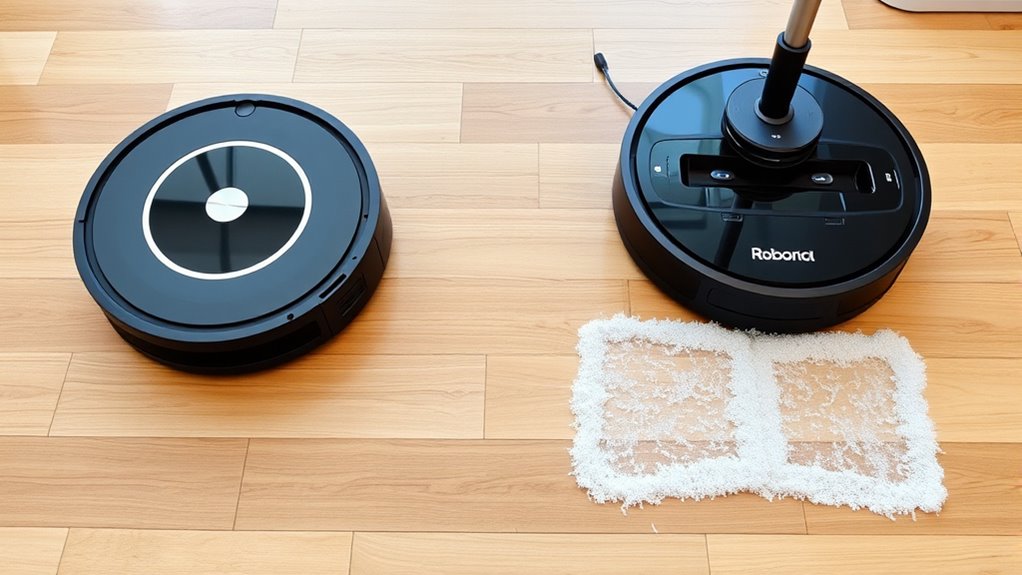
When it comes to mopping capabilities, the Roomba J9 and Roborock S8 excel in different ways that influence their effectiveness on hard floors. The Roomba J9 features a swinging mop arm that fully lifts the mop when it detects carpets, preventing wetting and protecting your carpets. In contrast, the Roborock S8 only lifts its mop 5 mm, so some dampness might reach carpets. Both models use vibrating semicircular mopping pads with consistent pressure to remove tough stains and dirt effectively. The Roborock S8’s mop pad is cleaned and dried automatically at its station, reducing maintenance effort. Meanwhile, the Roomba J9 lacks this feature, requiring manual cleaning. Self‑emptying technology enhances overall convenience and minimizes user intervention. Overall, Roomba’s design offers better carpet protection, while Roborock’s automated cleaning system enhances hygiene and ease of maintenance. Necessary cookies are employed to ensure core functionalities are maintained during mopping tasks, contributing to a seamless cleaning experience.
Base Station Features and Maintenance Procedures
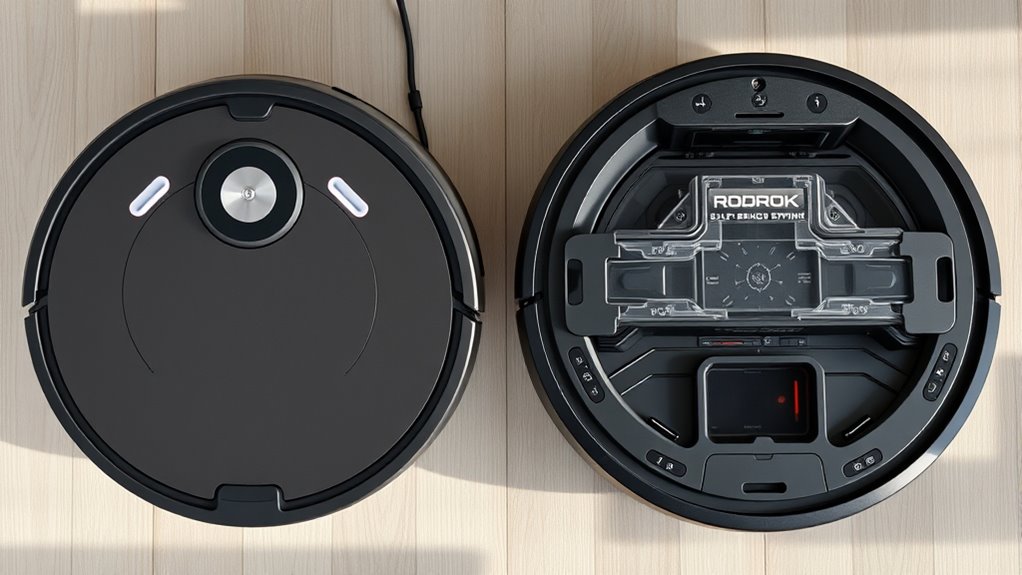
The base stations of the Roomba J9 and Roborock S8 are essential for maintaining their cleaning efficiency and ease of use, but they differ markedly in design and functionality. You’ll notice that the Roomba J9’s station features a wood-look top panel, blending with furniture, and primarily charges the robot while emptying dust into an internal bag. In contrast, the Roborock S8’s station includes tanks for clean and dirty water, plus a dust bag chamber for debris collection and mop maintenance. Both stations support self-emptying, reducing manual dustbin handling. The dust collection process is crucial for long-term maintenance and performance. Proper maintenance procedures ensure the longevity and optimal operation of these stations, especially as dust and debris accumulate over time.
Software Features and App Control Options

Both the Roomba J9 and Roborock S8 offer robust app control options that enhance user convenience and customization. You can create cleaning schedules, set virtual barriers, and view detailed maps of your home. The Roborock app delivers more granular control, including off-peak charging and faster cycle times. It also supports multi-floor mapping and regularly updates with new features. The Roomba app is simpler, focusing on quick access to cleaning history and straightforward operation. Both apps provide obstacle detection feedback and firmware updates for improved performance. Here’s a quick comparison:
| Feature | Roomba J9 | Roborock S8 |
|---|---|---|
| Mapping & Navigation | Advanced mapping, Keep-out Zones | Richer visuals, No-Go Lines |
| Customization | Basic preferences, history | Granular controls, logs |
| Obstacle Detection | AI obstacle avoidance | Advanced detection, real-time feedback |
| App Interface | Simple, post-cleaning info | Robust, detailed controls |
| Multi-floor Mapping | Not supported | Supported |
Price Points and Overall Value

When comparing the Roomba j9+ and Roborock S8 Pro Ultra, you’ll want to think about how their prices reflect their features and long-term costs. The Roomba offers advanced mop protection, while the Roborock provides longer runtime and self-cleaning systems that could save you money over time. Ultimately, your choice depends on which functions matter most and how much you’re willing to invest upfront.
Cost vs. Features
Although the Roomba J9+ comes at a premium price of around $1,400, it justifies this cost with advanced features like superior obstacle avoidance and a sophisticated mop lift system that keeps rugs dry. Its established brand and reliable performance add to its value. In contrast, the Roborock S8 Pro Ultra offers a more budget-friendly option with comparable high-end features, including an auto-cleaning and drying dock for the mop, reducing manual maintenance. Both models include self-emptying bases and smart app controls, but Roborock’s broader app features appeal to tech enthusiasts. Ultimately, the Roomba’s higher price reflects its brand reputation and refined obstacle handling, while Roborock balances cost with innovative docking technology for a better overall deal.
- Premium obstacle avoidance vs. advanced dock features
- Brand reliability and mop lift technology
- Cost efficiency with autonomous maintenance
Long-Term Maintenance Costs
Long-term maintenance costs for the Roomba J9 and Roborock S8 hinge on their consumables, energy use, and repair expenses, all impacting their overall value over time. Both require periodic replacement of dust bags and filters, with Roborock’s larger bags and mop pads potentially reducing frequency but increasing costs. Energy consumption is similar, though Roborock’s advanced app features can optimize usage and lower electricity bills. Repairs depend on parts availability and warranty coverage, with Roomba’s parts often priced higher. Overall, initial costs are higher for the Roomba J9, but ongoing expenses for consumables and repairs vary based on maintenance needs. Additionally, maintenance strategies such as proactive upkeep and understanding of repair needs can influence long-term costs. The table below summarizes key cost factors:
| Cost Aspect | Roomba J9 | Roborock S8 |
|---|---|---|
| Dust Bag Replacement | Every 30-60 days, higher cost | Similar, slightly less frequent |
| Filter Replacement | Every 2-3 months | Same |
| Mop Pad Replacement | Periodic, less wear | Several months |
| Repair & Warranty | Slightly higher parts cost | Slightly lower parts cost |
In addition, choosing cost-effective maintenance supplies and performing regular cleanings can extend the lifespan of both devices and reduce unexpected repair expenses.
Value for Multi-Functionality
The value for multi-functionality in robotic vacuums hinges on both their price points and the range of features they offer. You’ll find that the Roborock S8 Pro Ultra generally costs more but includes advanced features like auto-drying mops and higher suction power, making it ideal for thorough cleaning. The Roborock S8 Pro Ultra also emphasizes visionary quotes that inspire confidence in its innovative technology, which can justify its higher price for tech enthusiasts. The inclusion of UV filters and intelligent navigation enhances its cleaning efficiency and safety, adding to its overall value. Additionally, features like home furnishings integration can further elevate the device’s utility and convenience. The availability of alarm clock features in smart devices demonstrates how multi-functionality extends beyond cleaning, providing added value for users seeking all-in-one solutions. The Roomba Combo J9+ is more affordable, especially during sales, and still provides key functions like vacuuming, mopping, and self-emptying. Price fluctuations considerably impact perceived value, so it’s worth tracking discounts. Both models excel with obstacle avoidance and multi-surface cleaning. If you prioritize automation and extra features, Roborock’s higher price can be justified. Conversely, if budget is a concern, Roomba offers solid multi-functionality at a lower cost. Considering the importance of multi-surface cleaning, both devices are equipped to handle various floor types effectively.
Which Robot Fits Your Home Best?

Choosing the right robot vacuum depends on your home’s specific needs and layout. If you have mixed flooring and pet hair, the Roborock S8’s 6000 Pa suction and self-cleaning mop may suit you best, especially if longer runtime and advanced app features matter. For quieter operation and aesthetic integration, the Roomba J9’s 55 dB noise level and furniture-like base station could be ideal. Consider your priorities:
| Feature | Roomba J9 | Roborock S8 | Best For |
|---|---|---|---|
| Suction Power | 5000 Pa | 6000 Pa | Heavy debris, pet hair |
| Mop System | Auto-lift, manual cleaning | Auto-clean/dry, limited lift | Mopping on mixed flooring |
| Noise Level | 55 dB | 67 dB | Quiet environments |
Match features to your home’s needs for excellent cleaning.
Frequently Asked Questions
How Long Does Each Robot’S Battery Last per Full Charge?
You’re wondering how long each robot’s battery lasts per full charge. The Roomba J9 typically runs for about 60 to 75 minutes, depending on cleaning mode and home layout. In contrast, the Roborock S8 offers a much longer runtime, up to 180 minutes on a single charge, making it ideal for larger spaces. Both support automatic recharging, but the S8’s extended battery life lets you clean more area without interruptions.
Can Both Vacuums Handle Multi-Story Cleaning Efficiently?
Imagine guiding a team of skilled cleaners across multiple floors seamlessly. Both vacuums excel at multi-story cleaning thanks to advanced mapping, app controls, and obstacle avoidance. You can set no-go zones or keep-out areas, making it easy to customize each level. With self-emptying bases and detailed floor plans, they handle multi-story homes efficiently, letting you relax while your smart cleaners do the heavy lifting across your entire house.
Are Replacement Parts Widely Available for These Models?
You’ll find replacement parts for both models widely available. For the Roomba J9, iRobot offers official replenishment kits and individual accessories like filters and brushes directly on their website, making maintenance straightforward. Roborock’s S8 parts, including brushes, filters, and mop components, are accessible through their website, Amazon, and other retailers. Both support long-term upkeep with easy access to genuine parts, ensuring your vacuum stays in top shape.
How Do Noise Levels Compare During Operation?
Imagine a whisper in a busy room—that’s how the Roomba J9 operates, producing about 55 dB during cleaning, making it particularly quieter than the Roborock S8‘s 67 dB. You’ll notice the difference especially in quiet environments or during extended use. While the Roborock’s louder noise signals its powerful suction, the Roomba J9 offers a calmer, less disruptive experience, perfect if noise sensitivity matters to you.
What Are the Warranty and Customer Support Options?
You get a one-year limited warranty for both the Roomba J9 Plus and Roborock S8, covering defects and the battery. Customer support is accessible via phone, email, and live chat, with apps offering troubleshooting and updates. Replacement parts are widely available, but prices and regional availability vary. If issues arise, you can return or repair your device within the warranty period, making support options convenient and reliable.
Conclusion
Choosing between the Roomba j9 and Roborock S8 depends on your home’s needs. The Roomba j9 excels in obstacle avoidance, cleaning 95% of pet hair on carpets, while the Roborock S8 offers faster charging and longer battery life. If you have a busy household with pets, the j9’s self-emptying bin might be more convenient. Ultimately, select the robot that aligns best with your lifestyle to enjoy smarter, more efficient cleaning every day.

